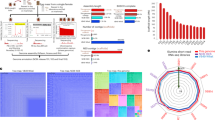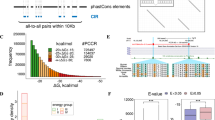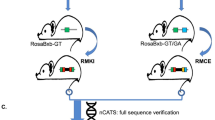Abstract
Evolution of the rDNA spacer, ITS 2, is examined by comparing 17 DNA sequences of the ticks, Ixodes scapularis and I. pacificus. The distribution of fixed interspecific differences and the relative frequency of base changes vs. insertions/deletions (indels) matches the distribution and relative frequency for intraspecifically variable sites. This suggests that most intraspecific variation is not effectively selected against. The base composition of the ITS 2 transcript is G- and U-biased. But, 5-base regions enriched (> 80 per cent) for A or U occur more frequently than expected while G-and C-enriched regions occur less frequently than expected. Enriched sequences may be prone to replication slippage, accounting for the A/T bias in insertions. Slippage-mediated gains and losses of A/T-rich tandem repeats apparently account for most indels. Minimum-energy conformations of the two species' folded transcripts share major structural features. Structural inertia arises from intramolecular base pairing within stems that allows most mutations to be absorbed as new bulges off stems. Yet, there is evidence of selection to maintain the conformation. First, intraspecifically variable sites are concentrated at the ends of stems in loops and intersections, structures that do not contribute to intramolecular base pairing. Moreover, some indels that have become fixed in one species compensate for the presence of conformation-destabilizing indels. However, high rates of sequence evolution within stems and absence of compensatory base evolution contraindicates selective constraint. Degenerate dispersed and tandem copies of two subrepeats, each approximately 20 bases long, may account for much of the ITS 2 sequence. These are approximate inverses of each other and are, consequently, capable of significant intramolecular hydrogen bonding to produce folded transcripts of low energy. Evolution of the ITS 2 sequence may largely entail replication slippage-mediated gains and losses of these repeats or their composite subrepeats.
Similar content being viewed by others
Article PDF
References
Amstutz, H, Munz, P, Heyer, W-D, Leupold, U, and Kohli, J. 1985. Concerted evolution of tRNA genes: intergenic conversion among three unlinked serine trna genes in S. pombe. Cell, 40, 879–886.
Arnheim, N, Krystal, M, Schmickel, R, Wilson, G, Ryder, O, and Zimmer, E. 1980. Molecular evidence for genetic exchanges among ribosomal genes on nonhomologous chromosomes in man and apes. Proc Natl Acad Sci USA, 77, 7323–7327.
Arnheim, N, Treco, D, Taylor, B, and Eicker, E M. 1982. Distribution of ribosomal gene length variants among mouse chromosomes. Proc Natl Acad Sci USA, 79, 4677–4680.
Beckingham, K. 1982. Insect rDNA. Cellnucl, 10, 205–263.
Boncinelli, E, Borhese, A, Graziani, E, La Mantia, G, Manzi, A, Miriani, C, and Simeone, A. 1983. Inheritance of the rDNA spacer in D. melanogaster. Mol Gen Genet, 189, 370–374.
Brimacombe, R, Maly, P, and Zwieb, C. 1983. The structure of ribosomal RNA and its organization relative to ribosomal protein. Nucl Acids Res Mol Biol, 28, 1–48.
Coen, E, Strachan, T, and Dover, G A. 1982. Dynamics of concerted evolution of ribosonal DNA and histone gene families in the melanogaster species subgroup of Drosophila. J Mol Biol, 158, 17–35.
Cummings, M P, King, L M, and Kellogg, E A. 1994. Slipped- strand mispairing in a plastid gene: rpo C2 in grasses (Poaceae). Mol Biol Evol, 11, 1–8.
Curtis, D, and Bender, W. 1991. Gene conversion in Drosophila and the effects of the meiotic mutants mei-9 and mei-218. Genetics, 127, 739–74.
Dallas, J F, Barton, N H, and Dover, G A. 1988. Interracial rDNA variation in the grasshopper, Podisma pedestris. Mol Biol Evol, 5, 660–674.
Devereux, J, Haeberli, P, and Smithies, O. 1984. A comprehensive set of sequence analysis programs for the VAX. Nucl Acids Res, 12, 387–395.
Dover, G A. 1982. Molecular drive: a cohesive mode of species evolution. Nature, 299, 111–117.
Dover, G A. 1986. Molecular drive in multigene families: how biological novelties arise, spread, and are assimilated. Trends Genet, 2, 159–165.
Dover, G A. 1989. Linkage disequilibrium and molecular drive in the rDNA gene family. Genetics, 122, 249–252.
Dover, G A, Brown, S, Coen, E S, Dallas, J, Strachan, T, and Trick, M. 1982. The dynamics of genome evolution and species differentiation. In: Dover, G. A. and Flavell, R. B. (eds) Genome Evolution, pp. 343–372. Academic Press, New York.
Freier, S M, Kierzek, R, Jaeger, J A, Subimoto, N, Caruthers, M H, Neilson, T, and Turner, D H. 1986. Improved free-energy parameters for predictions of RNA duplex stability. Proc Natl Acad Sci USA, 83, 9373–9977.
Fujiwara, H, and Ishikawa, H. 1986. Molecular mechanism of introduction of the hidden break into the 28S rRNA of insects: implication based on structural studies. Nucl Acids Res, 14, 6393–6401.
Gerbi, S A. 1985. Evolution of ribosonal DNA. In: Maclntyre, R. J. (ed.) Molecular Evolutionary Genetics, pp. 419–517. Plenum, New York.
Gillings, M R, Frankham, R, Speirs, J, and Whalley, M. 1987. X.- Y exchange and the coevolution of the X and Y rDNA arrays in Drosophila melanogaster. Genetics, 116, 241–251.
Gonzalez, I L, Gorski, J L, Campen, T J, Dorney, D J, Erickson, J M, Sylvester, J E, and Schmickel, R D. 1985. Variation among human 28S ribosonal RNA genes. Proc Natl Acad Sci USA, 82, 7666–7670.
Hancock, J M, and Dover, G A. 1988. Molecular coevolution among cryptically simple expansion segments in eukaryotic 26S/28S rRNA. Mol Biol Evol, 5, 377–392.
Hancock, J M, Tautz, D, and Dover, G A. 1988. Evolution of the secondary structures and compensatory mutations of the ribosomal RNAs of Drosophila melanogaster. Mol Biol Evol, 5, 393–414.
Hassouna, N, Michot, B, and Bachellerie, J-P. 1984. The complete nucleotide sequence of mouse 28S rRNA: implications for the process of size increase of the large subunit rRNA in higher eukaryotes. Nucl Acids Res, 12, 3563–3583.
Keirans, J E, Oliver, J H, and Needham, G R. 1992. The Ixodes ricinus/persulcatus complex defined. In: Mundetloh, U. G. and Kurtti, T. J. (eds) First International Conference on Tick-Borne Pathogens at the Host-Vector Interface, p. 302. University of Minnesota, St. Paul.
Lachance, M-A. 1990. Ribosomal DNA spacer variation in the cactophilic yeast Clavispora opuntiae. Mol Biol Evol, 7, 178–193.
Larson, A, and Wilson, A C. 1989. Patterns of ribosomal RNA evolution in salamanders. Mol Biol Evol, 6, 131–154.
Levinson, G, and Gutman, G A. 1987. Slipped-strand mispairing: a major mechanism for DNA sequence evolution. Mol Biol Evol, 4, 203–221.
Livak, K. 1984. Organization and mapping of a sequence on the Drosophila melanogaster X and Y chromosomes that is transcribed during spermatogenesis. Genetics, 107, 611–634.
Lohe, A R, and Roberts, P A. 1990. An unusual Y chromosome of Drosophila simulans carrying amplified rDNA spacer without rDNA genes. Genetics, 125, 399–406.
Lyckegaard, E M S, and Clark, A G. 1991. Evolution of ribosomal RNA gene copy number on the sex chromosomes of Drosophila melanogaster. Mol Biol Evol, 8, 458–474.
Maddern, R H. 1981. Exchange between ribosomal RNA genes of X and Y chromosomes in Drosophila melanogaster males. Genet Res, 38, 1–7.
McLain, D K, Wesson, D M, Oliver, J H. Jr, and Collins, F H. 1995. Variation in rDNA ITS 1 among eastern populations of Ixodes scapularis (Acari: Ixodidae). J Med Entomol, 32, 353–360.
Michot, B, and Bachellerie, J-P. 1987. Comparisons of large subunit rRNAs reveal eukaryote-specific elements of secondary structure. Biochemie, 69, 11–23.
Mullis, K B, Faloona, F A, Scharf, S J, Saiki, R K, Horn, G T, and Erlich, H A. 1986. Specific enzymatic amplification of DNA in vitro: the polymerase chain reaction. Cold Spring Harbor Symp Quant Biol, 51, 263–273.
Ohta, T. 1983. On the evolution of multigene families. Theor. Pop Biol, 23, 216–240.
Ohta, T, and Dover, G A. 1984. The cohesive population genetics of molecular drive. Genetics, 108, 501–521.
Oliver, J H. Jr. Owsley, M R, Hutcheson, H J, James, A M, Chen, C, Irby, W S, Dotson, E M, and McLain, D K. 1993. Con-specificity of the ticks Ixodes scapularis and I. dammini (Acari: Ixodidae). J Med Entomol, 30, 54–63.
Olsen, G J, McCarrol, R, and Sogin, M L. 1983. Secondary structure of Dictyostelium discoideum small subunit ribosomal RNA. Nucl Acids Res, 11, 8037–8049.
Paskewitz, S M, Wesson, D M, and Collins, F H. 1993. The internal transcribed spacers of ribosomal DNA in five members of the Anopheles gambiae species complex. Insect Mol Biol, 2, 247–257.
Reddy, R, Rothblum, L I, Subrahmanyam, C S, Liu, M-H, Henning, D, Sidy, B, and Busch, H. 1983. The nucleotide sequence of 8S RNA bound to preribosomal RNA of Novikoff hepatoma. J Biol Chem, 258, 584–589.
Robbins, L G, and Swanson, E E. 1988. Rex-induced recombination implies bipolar organization of the ribosomal RNA genes of Drosophila melanogaster. Genetics, 120, 1053–1059.
Sambrook, J, Fritsch, E F, and Maniatis, T. 1989. Molecular Cloning. Cold Spring Harbor Press, Plainview, NY.
Sanger, F, Nicklen, S, and Coulsen, A R. 1977. DNA sequencing with chain terminating inhibitors. Proc Natl Acad Sci USA, 74, 5464–5468.
Savino, R, and Gerbi, S A. 1990. In vivo disruption of Xenopus U3 snrna affects ribosomal RNA processing. EMBO J, 9, 2299–2308.
Spielman, A, Clifford, C M, Piesman, J, and Corwin, M D. 1979. Human babesiosis on Nantucket Island, USA: description of the vector, Ixodes (Ixodes) dammini, n. sp. (Acarina: Ixodidae). J Med Entomol, 15, 218–234.
Stewart, D T, and Baker, A J. 1994. Patterns of sequence variation in the mitochondrial D-loop region of shrews. Mol Biol Evol, 11, 9–21.
Strachan, T, Webb, D, and Dover, G A. 1985. Transition stages of molecular drive in multi-copy DNA families in Drosophila. EMBO J, 4, 1701–1708.
Tautz, D, Hancock, J M, Webb, D A, Tautz, C, and Dover, G A. 1988. Complete sequences of the rRNA genes of Drosophila melanogaster. Mol Biol Evol, 5, 366–376.
Tautz, D, Tautz, C, Webb, D, and Dover, G A. 1987. Evolutionary divergence of promoters and spacers in the rDNA family of four Drosophila species: implications for molecular coevolution in multigene families. J Mol Biol, 195, 525–542.
Thweatt, R, and Lee, J C. 1990. Yeast precursor ribosomal RNA: molecular cloning and probing the higher-order structure of the internal transcribed spacer 1 by kethoxal and dimethylsulfate modification. J Mol Biol, 211, 305–320.
Walsh, J B. 1987. Persistence of tandem arrays: implications for satellite and simple-sequence DNAS. Genetics, 115, 553–567.
Ware, V C, Tague, B W, Clark, C C, Gourse, R L, Brand, R C, and Gerbi, S A. 1983. Sequence analysis of 28S ribosomal DNA from the amphibian Xenopus laevis. Nucl Acids Res, 11, 7795–7817.
Wesson, D M, and Collins, F H. 1992. Sequence and secondary structure of 5.8S rRNA in the tick, Ixodes scapularis. Nucl Acids Res, 20, 1139.
Wesson, D M, McLain, D K, Oliver, J H, Piesman, J, and Collins, F H. 1993. Investigation of the validity of species status of Ixodes dammini (Acari: Ixodidae) using rDNA. Proc Natl Acad Sci USA, 90, 10221–10225.
Wesson, D M, Porter, C H, and Collins, F H. 1992. Sequence and secondary structure comparisons of ITS rDNA in mosquitoes (Diptera: Culicidae). Mol Phylogen Evol, 1, 253–269.
Williams, S M, Kennison, J A, Robbins, L G, and Strobeck, C. 1989. Reciprocal recombination and the evolution of the ribosomal gene family of Drosophila melanogaster. Genetics, 122, 617–624.
Yeh, L-C C, and Lee, J C. 1990. Structural analysis of the internal transcribed spacer 2 of the precursor ribosomal RNA from Saccharomyces cerevisiae. J Mol Biol, 211, 699–712.
Zuker, M, and Steigler, P. 1981. Optimal computer folding of large RNA sequences using thermodynamics and auxiliary information. Nucl Acids Res, 9, 133–148.
Author information
Authors and Affiliations
Rights and permissions
About this article
Cite this article
McLain, D., Wesson, D., Collins, F. et al. Evolution of the rDNA spacer, ITS 2, in the ticks Ixodes scapularis and I. pacificus (Acari: Ixodidae). Heredity 75, 303–319 (1995). https://doi.org/10.1038/hdy.1995.139
Received:
Issue date:
DOI: https://doi.org/10.1038/hdy.1995.139
Keywords
This article is cited by
-
Molecular characterization of Ribosomal DNA (ITS2) of hard ticks in Iran: understanding the conspecificity of Dermacentor marginatus and D. niveus
BMC Research Notes (2020)
-
Comparative vector competence of North American Lyme disease vectors
Parasites & Vectors (2020)
-
Secondary structure of the internal transcribed rDNA (ITS) regions of Cosmopolites sordidus (Germar) and Odoiporus longicollis (Olivier): a first report in family Curculionidae
International Journal of Tropical Insect Science (2019)
-
Species identification of Ixodes granulatus (Acari: Ixodidae) based on internal transcribed spacer 2 (ITS2) sequences
Experimental and Applied Acarology (2011)
-
Geographically localised bursts of ribosomal DNA mobility in the grasshopper Podisma pedestris
Heredity (2009)



